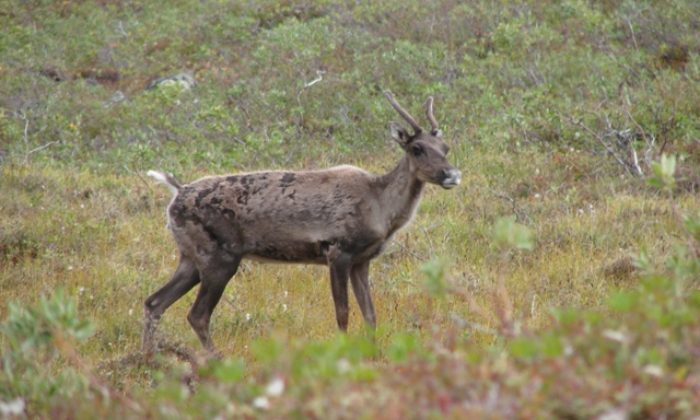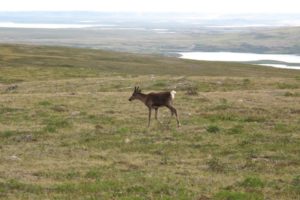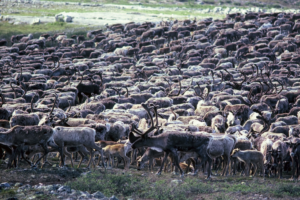Barren-ground Caribou
Biology
Barren-ground caribou (Rangifer tarandus groenlandicus) are part of the deer family and are a subspecies of caribou (Rangifer tarandus). Barren-ground caribou can resemble woodland caribou but are slightly smaller and lighter in colour, have shorter legs and a shorter face, and have smaller and narrower antlers. They have a white mane and white underbelly while the rest of them is a dark brown. This colouring is the most distinct in the summer while in the fall they appear to be a more uniform light brown, and in the winter their colouring appears to be more faded and light beige. Their velvet antlers are brown in colour. Females weigh between 85 to 135 kg and males between 100-140 kg.

Range
In the Northwest Territories, scientists observe nine different herds of barren-ground caribou. This includes: Porcupine, Cape Bathurst, Tuk Peninsula, Bluenose West, Bluenose East, Bathurst, Beverly, Ahiak, and Qamanirjuaq. Many of the herds move between seasonal habitats that are in different political jurisdictions. For example, the Porcupine population uses habitat mostly in the Yukon and has calving grounds in Alaska, but in some years ranges into the NWT. The map shows the extensive ranges of barren-ground caribou that occupy the NWT at some point in their annual migration.

Habitat
Barren-ground caribou migrate from winter feeding grounds below the treeline north to calving grounds in March and April. Calving habitat is often at a higher elevation than surrounding areas this choice of habitat allows for predator avoidance and refuge from insects. Calving grounds can be as far as 700 kms away from their winter habitat. Barren-ground caribou have calves in groups and travel together. Once the calves are born in June they gather in large groups to forage and migrate to summer habitat. In August the caribou disband into smaller groups or may join with non-breeding cows and bulls as they make their way to the taiga treeline. They feed on lichen, grasses, sedges, shrubs and mushrooms in summer and fall. In winter they move around to look for sedges, lichen and leaves in areas with shallow snow or lichen found on mature black spruce.
Ecological and Cultural Significance
Barren-ground caribou are important ecologically, culturally, and spiritually. Harvesting has provided food security for many communities, as well as a spiritual and cultural connection for millenia.
Population and Threats
The Bluenose East, Bathurst and Tuk Peninsula populations have declined significantly, there is concern that the Beverly and Qamanirjuaq populations are entering a significant decline. The Bluenose West population is considered to be stable, the Cape Bathurst population is stable or increasing while the Porcupine has recovered from low numbers.The status of the Ahiak population is unknown. In the Northwest Territories population counts are obtained through aerial surveys, the most recent data published is from 2018. The Bluenose East herd is estimated at 19,300, which is down from 39,000 in 2015. The Bathurst herd is estimated at 8,200, which is down from 20,000 in 2015. The Tuk Peninsula herd is estimated at 1,500 which is down from 1,900 in 2015. The Bluenose West herd is estimated at 21,000 which is stable from 2015. The Cape Bathurst herd is estimated at 4,500 which is up from 2,500 in 2015. The Porcupine herd is estimated at 218,000 in 2017, which is up from 197,000 in 2013. The Beverly, Qamanirjuaq, and Ahiak herds were surveyed by the Government of Nunavut. The Beverly herd is estimated at 103,000 in 2018, which is down from 136,000 in 2011. The Qamanirjuaq herd is estimated at 288,000 in 2017 which is down from 344,000 in 2008. The Ahiak herd is estimated at 71,000 in 2011. Barren-ground caribou naturally experience cycles of high and low populations. The current low end of this cycle is thought to be exacerbated by climate change, habitat loss, resource development and exploration, increased access for predators and hunters along new roads, and increased frequency and intensity of forest fires.
Management
Barren-ground caribou are listed as threatened under the Northwest Territories List of Species at Risk, were assessed as threatened by COSEWIC and are currently under consideration by the Federal Species at Risk Act list. The NWT listing does not include the Porcupine herd as they are considered to be a separate, distinct population. The Porcupine herd is listed as Not at Risk in the NWT. Co-management of barren-ground caribou is established under land claim agreements in the Inuvialuit, Gwich’in, Sahtú, and Tłı̨chǫ.
Several regional wildlife management authorities, the GNWT, and Environment and Climate Change Canada share responsibilities for caribou. This includes developing and implementing stewardship plans for the herds. Community conservation plans are an example, the Délįnę community has established its own caribou management plan- A Délįnę Got’įnę Plan of Action, and Łutsël K’é Dene First Nation has a community-led caribou stewardship plan called Yúnethé Xá Ɂetthën Hádi. Other examples include Taking Care of Caribou which is a management plan for the Cape Bathurst, Bluenose West, and Bluenose East herds. It was developed by the Advisory Committee for Cooperation on Wildlife Management which is comprised of chairpersons from the Wildlife Management Advisory Council (NWT), The Gwich’in Renewable Resource Board, the Ɂehdzo Got’ın̨e Gots’e Nakedı (Sahtú RenewableResources Board), the Wek’èezhìi Renewable Resources Board, the Kitikmeot Regional Wildlife Board, and the Tuktut Nogait National Park Management Board.
The Bathurst Caribou Range Plan was developed by the Government of Northwest Territories in 2019 and is an advisory document. The main goal of the plan is to ensure the Bathurst herd annual range is in a resilient landscape condition. The four objectives to support this are: 1. Ensure the integrity of important habitats 2. Ensure connectivity between seasonal ranges 3. Ensure the amount of human-caused land disturbances is kept below certain levels and 4. Ensure the development, design and use of roads is managed with consideration to caribou.
The Beverly and Qamanirjuaq Caribou Management Board was established to protect and ensure the long-term conservation of the two herds in the interest of Indigenous peoples. The board is composed of members from NWT, Nunavut, Manitoba and Saskatchewan. The Beverly and Qamanirjuaq Caribou Management Plan 2013-2022 details how the BQCMB will work with governments, communities and others in order to protect the caribou herds.
Regional Wildlife Management Authorities
The Nunavut Wildlife Management Board is the main source of wildlife management in the Nunavut Settlement Area. They help to manage the Beverly, Qamanirjuaq, and Ahiak herds in conjunction with other governments, including the Government of the Northwest Territories.
The Wek’èezhìi Renewable Resources Board manages wildlife and wildlife habitat in the Wek’èezhìi area. The Ahiak, Beverly, Bathurst, and Bluenose East herds are within this range.
The Gwich’in Renewable Resources Board provides recommendations on management of the Cape Bathurst, Porcupine, and Bluenose West herds in the Gwich’in Settlement Area. The Gwich’in Renewable Resource Councils encourage community participation in conservation, harvesting studies, research and management of the Cape Bathurst, Porcupine, and Bluenose West herds in the Gwich’in Settlement Area.
The Sahtú Renewable Resources Board provides recommendations on management of the Bluenose West and Bluenose East herds in the Sahtú Settlement Area. The Sahtú Renewable Resource Councils encourages community participation in conservation, harvesting studies, research and management of the Bluenose West and Bluenose East herds within the Sahtú Settlement Area.
Resources
- Government of Northwest Territories- Environment and Natural Resources
- Barren-ground Caribou Co-Management
- NWT Species at Risk
- Nunavut Wildlife Management Board
- Wek’èezhìı Renewable Resources Board
- Beverly and Qamanirjuaq Caribou Management Board
- Bathurst Caribou Range Plan
- Sahtú Renewable Resources Board
![CPAWS NWT Logo [Transparent Background] CPAWS NWT](https://cpawsnwt.org/wp-content/uploads/2018/09/CPAWS-NWT-Logo-Transparent-Background.png)



